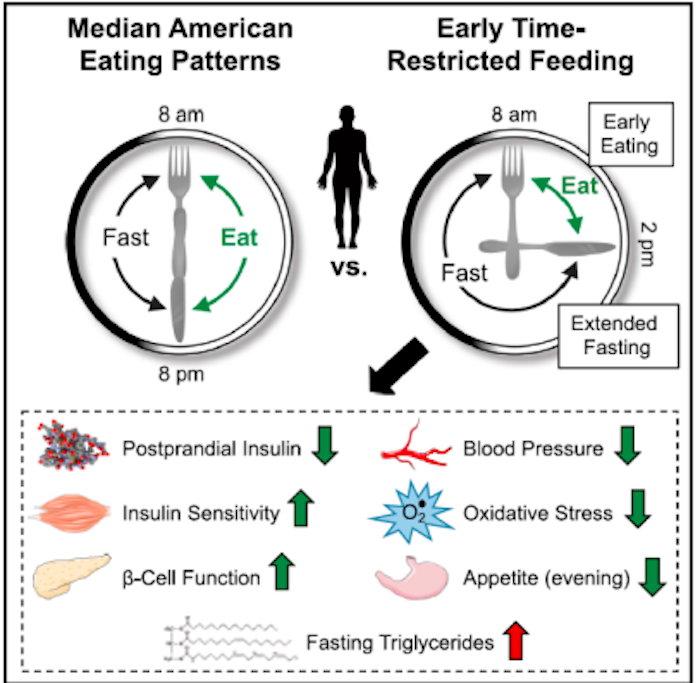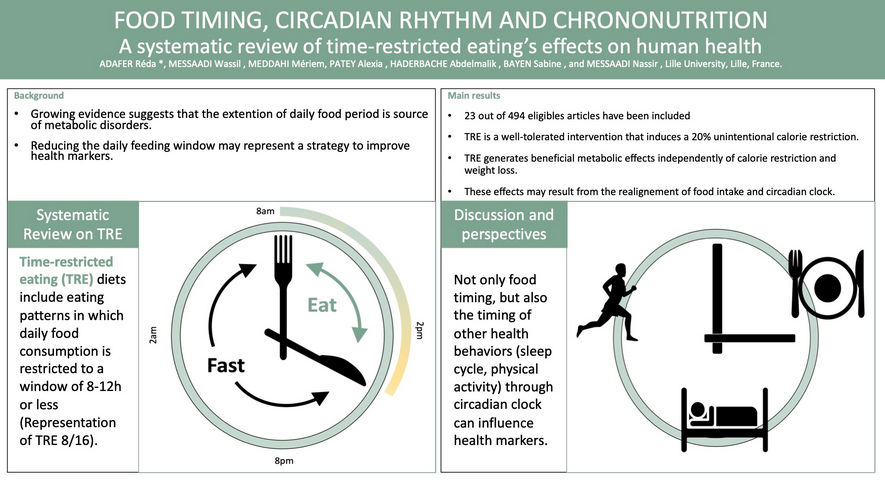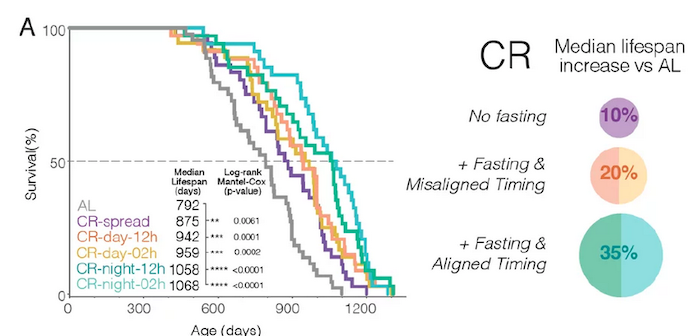Sync Your Circadian Rhythms and Time Restricted Feeding to Optimize Health
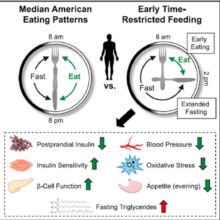
To sync circadian rhythms and time restricted feeding means to eat within a restricted time frame that does not extend into the late evening before bed. Can you eat all your food within a 12, 10 or 8 hour window, and put your last bite in your mouth 2 to 3 hours before you go to bed? Doing that will put you on track to lose body fat, have more energy, be metabolically healthy — and maybe even extend your lifespan.
Living your life in sync with circadian rhythms and time restricted feeding can help you lose body fat, become metabolically healthier, give you more energy and possibly extend your lifespan. That’s the conclusion of numerous studies on the subject, none more highly regarded as those done by a pioneer in the field, Satchin Panda, PhD.
A few days ago, Rangan Chatterjee, MD interviewed Dr. Panda about what research in both mice and humans conclude about the importance of living a life aligned with your circadian rhythms and time restricted feeding.
As Dr. Chatterjee notes in the interview (see video below), Dr. Panda’s research is largely responsible for the highly popular phenomenon referred to as “intermittent fasting”; typically called “time restricted eating” (TRF) by scientists. Panda’s first paper on the topic that kicked off this fascination with TRF and the benefits derived by its practice was published ten years ago. That experiment was done with mice, but as you’ll learn in this post, TRF has been studied in humans, and very similar metabolic and weight loss health benefits accrue to them as well when practicing TRF, especially when done in line with circadian rhythms, a subject that Dr. Panda is also a world-wide recognized expert.
Because the video interview is over two hours, and some of the subject material is complex, I’ve summarized much, but not nearly all, of the interview. If you have the time and inclination, I recommend you watch the video and then read my summary. If, however, you’re short on time, you’ll glean what’s important by reading my summary.
Content
Let’s dig in…
Dance to Your Circadian Rhythms and Shorten Your Feeding Window
Dr. Panda’s research background involves circadian rhythms or 24 hours rhythms and time restricted feeding. His aim is to understand how an animal’s peak performance — whether it be metabolic, physical, biochemical or intellectual — as well its lifespan — is affected by its circadian clock, caloric restriction and the time frame within which it eats.
We all evolved on this planet with a 24 hours light/dark cycle and an eating/fasting cycle that by design endeavors to have at least 12 to 14 hours of fasting every day. This fasting period needs to be consistent from day to day so that the body’s internal circadian program recognizes when the fasting period is going to occur. For instance, if your last bite of dinner happens at six o’clock in the evening, the fasting period will not begin until 11:00, because that dinner is going to be digested over the next five hours.
Your body is not fasting while digesting. The food goes to the stomach and then to the intestines where 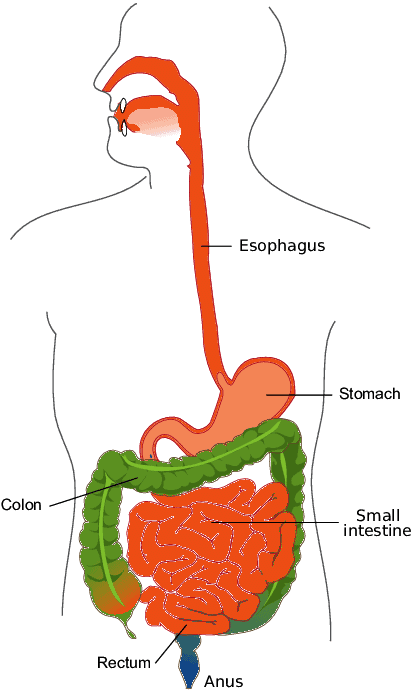 nutrient absorption occurs for a few hours, during which time the body is using most of the glucose and stored glycogen that we use as fuel. Glycogen (stored glucose) reserves begin running low within seven to ten hours after eating, after which the body begins to use body fat (adipose tissue) for energy.
nutrient absorption occurs for a few hours, during which time the body is using most of the glucose and stored glycogen that we use as fuel. Glycogen (stored glucose) reserves begin running low within seven to ten hours after eating, after which the body begins to use body fat (adipose tissue) for energy.
When your fasting period aligns with your sleep then body repair and restoration is optimized. For instance, the gut lining and many parts of our body gets damaged throughout the day, and is best repaired during deep sleep and when we’re fasting. Under those conditions, your pituitary gland will produce growth hormones that will travel to many parts of your body, including the gut lining, and trigger repair processes. After a12 to 14 hours, the body will break down enough stored fat to produce ketones (a type of chemical that your liver produces when it breaks down fat), which provide fuel for the body, substituting for the depleted glucose and glycogen.
Ketones are thought to be anti-inflammatory (very important for extending healthspan), and they are also signaling molecules, meaning they can instruct the cell to turn on different kinds of programs that support health.
One of Panda’s experiments discovered that by imposing a strong feeding fasting cycle in mice, they could see that nearly 80+% of the genes were changing what time they were turned on or off, or how high or low they were going up or down. This indicates that by changing your eating time you can be the master conductor of your whole genetic program.
Panda underscores that various TRF experiments with humans are also showing similar results as those with mice. Dr. Chatterjee supports that contention, given his clinical experience as a medical doctor. He says he is finding that when people control the timing of their food, they sleep better, their craving for processed foods decline, and their body’s repair processes improve. Moreover, those who restrict their feeding window to eight to ten hours eat between five and 20 percent fewer calories.
The Ideal Body Clock for Rejuvenation and Repair
Panda says that when we awaken the hormones melatonin and cortisol are still elevated. The melatonin can cause drowsiness for up to two hours, and cortisol is still climbing and won’t reach its peak for about 45 minutes. In this state, your body is not ready to digest food. Melatonin inhibits glucose induced insulin released from the pancreas, which means that blood glucose spikes resulting from a meal will not properly be shuttled via insulin from the bloodstream into cells where it can be used for energy.
Ideally, what you could do in the first hour after waking up to reset your circadian clock by getting sunlight. Caffeine can reset the clock as well, but getting strong exposure to morning light has many other benefits that caffeine doesn’t offer, such as to synchronize your brain circadian clock, and to reduce sleepiness and depression.
Go to a window flooded with light, or go outside soon after you arise in the morning. You need around 1,000 lux of light for about 30 minutes to an hour to synchronize your clock and to reduce sleepiness and depression. Even on a cloudy day, approximately 5,000 to 10,000 lux is emitted, and you’re getting exposed to around 800 to 1,000 lux if sitting by a window as you sip your coffee or tea. Better yet, go for a morning walk before eating or drinking anything except water.
The Brain and Body Clocks Get Activated Differently
The brain’s circadian clock gets set by light, and the body’s circadian clock gets set by food.
Almost every cell in our body, and every organ has its own circadian clock. They need to be synchronized. That means our liver clock should be in sync with our gut clock; when that happens, the gut’s timing pertinent to when the digestive juice is produced is synchronized with the liver’s ability to process all the nutrients.
If you decide to eat in the middle of the night, your body clock reacts as if you traveled to a different time zone, and will try to reset as if it’s daytime, and will attempt to do so the next day in anticipation of a pattern that’s being set. Given that your normal time to eat is not in the middle of the night, your body clock is not ready for food, and your digestive system is, in effect, asleep. So, in this instance, when food is eaten, digestion is impaired, because the gut is not producing a sufficient amount of acid, resulting in poor nutrient absorption.
What’s the Best TRF Window for You?
The answer to that is the same as the answer to the question, What’s the best exercise for me?
The answer to both is, Whichever (TRF or exercise) you’re willing to do consistently.
Whatever window you elect to do for your TRF, it begins with breakfast. Breakfast is thought to be a morning meal, but really it’s whenever you first eat after fasting during sleep. It’s important to break your fast (breakfast) at a regular time each day in order to re-synchronize all your clocks for the day.
In determining what time should you have breakfast, keep the following thoughts in mind:
(1) Assuming you finish dinner at 6:00 PM, you’ll need some hours to digest the meal and eight hours of sleep, and an hour in the morning to get some sunlight and let your melatonin and cortisol hormones subside. Say all that takes 11 hours, leaving 13 hours within which you can choose a “feeding window” of some number of hours.
(2) Clinical studies that had people eat within a 12-hour window did not show any benefit to them, unless they were eating during a 16-hour window prior to such studies. Turns out, that’s a lot of people. Dr. Panda’s app My Circadian Clock records participants’ feeding window to average 15 hours or more. In that case, a three hour reduction to 12 hours does show health benefits.
(3) Dr. Chatterjee encourages most of his patients to first reduce their feeding window to 12 hours in order to maximize compliance. Unless there are extenuating circumstances, most of his patients can sustain 12 hours to start.
(4) Dr. Panda relates that in a study he did, the cohorts were overweight humans bereft of serious health complications, such as high blood pressure or high blood glucose. They were asked to eat within 10 hours, whereby the first meal would be no earlier than one hour after awakening, and the last meal would be eaten between two and three hours prior to bed. Even allowing for one cheat day per week, participants experienced multiple health benefits. In people who had one or multiple items of metabolic syndrome (obesity, high blood pressure, high triglyceride or high blood sugar), improvement was seen in nearly all of these elements.
(5) There’s a lot of research that supports the health benefits of consuming the bulk of calories during the first half of our day compared to the second half of the day. One reason for this is that we have better glucose control earlier in the day when our insulin producing cells can manage high glycemic (high sugar) foods (like simple carbs). Later in the day is best for eating food low in sugar and higher in fats and protein.
Blue Light During the Day, Amber at Night
We covered that food and light sets, respectively, the body and brain’s circadian clocks. For diurnal animals such as humans, these both typically happen in the early part of the day, but what about light at night? For most of the time that humans were humans, we did not experience much light at night. After sunset, perhaps a fire or candles — and neither contain much blue light.
Blue light has a very short wavelength that is detectable by the human eye. Notwithstanding artificial light, we get most of it from sunlight. Not only does blue light provide basic illumination, but it also helps to increase feelings of well-being. But there’s a time and place for blue light, and that’s not at night before bed.
The blue light that’s emitted from the screens of our various devices (computers, tablets, phones and TVs) can delay the release of sleep-inducing melatonin, increase alertness, and reset the body’s internal clock to a later schedule. Fluorescent lights and some types of LED light bulbs also emit higher levels of blue light compared to incandescent bulbs. In the modern world, our nights are flooded with blue light, and that can be a problem for restorative sleep.
Here are Dr. Panda’s simple rules for light at night, beginning at two to three hours before bedtime:
- Avoid exposure to bright light
- Put your lights on a dimmer and dim them
- Use a table lamp to direct any direct light to the book you’re reading or on your workspace
- If using a computer, dim the screen (or you can install f.lux)
- Dim the light brightness on your phone
- Use low-blue light, amber bulbs
- Wear blue light blocking glasses (my suggestion, not Panda’s)
Sync Your Circadian Rhythms and Time Restricted Feeding to Optimize Health
In Dr. Panda’s seminal study done ten years ago, mice were put on a treadmill to measure how long they could run before becoming exhausted:
- Mice consuming an unhealthy diet ad libitum could run around 45 minutes.
- Mice on a healthy diet eating ad libitum could run around 60 minutes.
- Mice eating a healthy diet within an eight-hour window could run for 120 minutes.
This study showed that restricting food intake during an eight-hour window conferred some energetic and physical performance benefits. But since then, there’s been a debate about what is more important for conferring health and lifespan benefits — caloric restriction or the time duration within which food is consumed within an animal’s natural circadian rhythms; for instance, daytime for humans and nighttime for mice.
Panda says that a recent study published in the journal Science endeavors to answer that question, but only the abstract is currently available to the public, so I’m going to rely on Arkadi Mazin’s excellent review of the study that he wrote for Lifespan.io.
In order to discern the relative strengths of caloric restriction vs TRF on the health and lifespan outcomes of mice, the researchers divided male mice into six groups:
- Group 1, the control group, was fed ad libitum 24 hours per day; all other groups were calorically restricted to 30% less than the control. Their median lifespan was 792 days, normal for this type of mice.
- Group 2 received food throughout the day every 160 minutes, thus negating any influence of TRF. They lived 10% longer than controls (Group 1).
- Group 3 was fed for 2 hours during the day, an unnatural time to be fed for a nocturnal animal. They lived 21% longer than controls
- Group 4 was fed 12 hours; again, during the day. They lived for 19% longer than controls.
- Group 5 was fed for 2 hours during the night (the natural time to eat for mice). They lived for 35% longer than controls.
- Group 6 was fed for 12 hours during the night. They lived for 33.4% longer than controls.
In conclusion, the study demonstrated that:
Circadian rhythms and uninterrupted sleep are important. The sleep of mice that ate during the day was interrupted since, being nocturnal, they sleep during the day. This sleep interruption in combination with being fed during the day might have been responsible for their shorter lifespans relative to those that were fed at night.
Caloric restriction in combination with TRF have a synergistic effect. Caloric restriction extended life span as expected, but it worked best when feeding was restricted so that the animals fasted for at least 12 hours, and when the period in which the animals ate corresponded to the active phase of their circadian cycle (at night). The researchers found 159 genes that responded specifically to intermittent fasting rather than caloric restriction, confirming that their effects are at least somewhat additive. 69 genes were specifically protected against age-related expression changes in groups that were restricted to low-calorie nightly feedings.
Reducing the feeding window to 2 hours seems to add little value. The group with a TRF window of 2 hours lived slightly longer (35% longer life) compared to the group with a TRF window of 12 hours (33.4% longer life).
Caloric restriction confers metabolic benefits. Insulin levels increased with age in the control group, but this increase was reduced in all other groups.
Your Takeaway
Let’s end with Dr. Satchin Panda’s six top tips:
- Go to bed at a consistent time and try to be in bed for eight hours so that you can get seven hours of sleep.
- In the morning wait for at least an hour after waking up before eating or drinking anything other than water, because that’s the “changing of the guards” — the night hormones are going down, the day hormones are coming up, and your body is not yet ready to digest food.
- Be consistent with when you eat breakfast, and then eat for the next eight, nine, ten, or a maximum of 12 hours; meaning, your TRF window is between eight and 12 hours.
- Go outdoors for at least 30 minutes in the early daylight, even if it’s cloudy, because light synchronizes our brain clock, is an antidepressant, reduces sleepiness, and improves our executive function.
- Exercise anytime during the day, but physical activity is better in the afternoon, because that’s when your muscles are ready, your flexibility is better, it improves blood glucose (which typically declines in the late afternoon and evening), and your risk for injury is lower.
- No food or bright light two to three hours before bedtime so that you’re in sync with the “changing of the guards” when the day hormones are going down and the night hormones are coming up.
Do yourself a favor by checking out Dr. Panda’s latest book:
Last Updated on November 8, 2022 by Joe Garma

